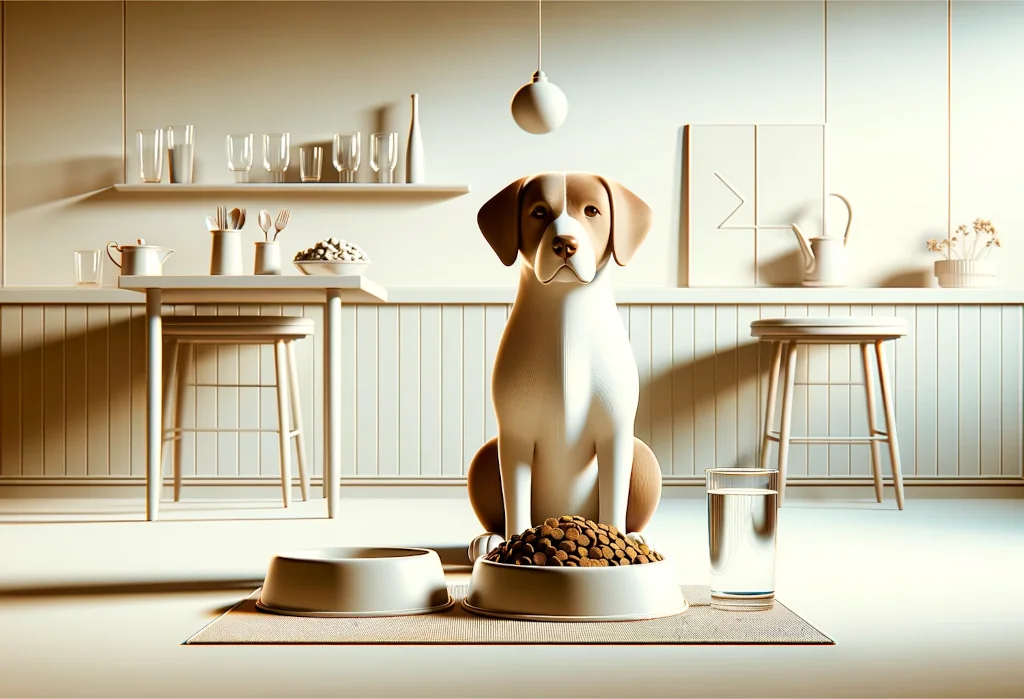We’ve all been there – staring into those big, begging eyes under the dinner table, wondering if we’re feeding Fido right or if that last treat was one too many. Between the myriad of dog diets and the fine line between spoiling and starving, finding the right portion size feels more like alchemy than science.
What you’re going to walk away with today is a clear guide on feeding your dog the right way, portion sizes included. Let’s make mealtime less of a guessing game and more of a science, with a pinch of love, of course.
Key takeaways:
- Tailor your dog’s meal portions based on their activity level and regular weight checks to prevent obesity and undernourishment.
- Treats should constitute no more than 10% of your dog’s daily caloric intake; factor them into the overall meal plan to maintain a balanced diet.
- Consistency in meal times promotes better digestion and reduces anxiety, making a significant difference in your dog’s health and happiness.
Why is the Correct Portion Size So Important for My Dog’s Health?
Finding the Goldilocks zone for your dog’s meal portions – not too much, not too little, but just right – is crucial for their well-being.
Here’s the scoop: proper portion sizes play a pivotal role in maintaining your furry friend’s ideal weight. Overfeeding leads to weight gain and can open a Pandora’s box of obesity-related health issues, such as diabetes, heart disease, and joint problems. On the flip side, underfeeding can leave your dog undernourished, affecting their energy levels and immune system.
But it’s not just about quantity – it’s also about quality and balance. Ensuring your dog gets the right amount and the right kind of food means they’re getting a balanced diet. This balance is essential for their overall health, providing them with the vitamins, minerals, and nutrients needed to keep their tails wagging.
How Can I Determine the Right Portion Size for My Dog?
Let’s dive into the nitty-gritty of tailoring the perfect meal plan for your pooch. Here are some hands-on tips to figure out the right portion size:
-
Consider Your Dog’s Energy Needs: An active, energetic dog will have different caloric needs from a couch potato. Use this as a starting point. For example, a highly active dog might need up to 40% more food than the guidelines suggest, while a more sedentary dog might need less.
-
Weigh Your Dog Regularly: Keeping tabs on your dog’s weight will help you adjust their food portions as needed. A sudden weight gain or loss is a sign that you need to tweak their diet.
-
Check The Food’s Guidelines: Dog food labels provide feeding recommendations based on a dog’s weight. Treat these as a baseline and adjust according to your dog’s specific needs.
-
Consult with Your Vet: Your vet can offer tailored advice based on your dog’s health, lifestyle, and nutritional needs. They can also recommend a feeding schedule that aligns with your pet’s requirements.
One unique tip that most might not consider is the role of measuring cups and scales in feeding: Instead of eyeballing your dog’s portions, use a kitchen scale or measuring cup to ensure accuracy. Precise measurements can make a remarkable difference in managing your dog’s weight.
Use this table to get a general idea of daily portion sizes based on your dog’s weight:
| Dog’s Weight (lbs) | Dry Food (Cups/Day) | Wet Food (Cups/Day) |
|---|---|---|
| 10 | 1 – 1 1/3 | 1 1/4 – 1 1/2 |
| 20 | 1 3/4 – 2 1/4 | 2 – 2 1/2 |
| 30 | 2 1/4 – 3 | 2 3/4 – 3 1/4 |
| 40 | 2 3/4 – 3 1/2 | 3 1/2 – 4 |
| 50 | 3 1/4 – 4 | 4 – 4 3/4 |
| 60+ | 3 3/4+ | 4 1/2+ |
This table serves as a starting point to gauge how much you should be feeding your dog daily. Remember, every dog is unique, and factors like age, breed, activity level, and health condition will influence the exact portion size. It’s essential to monitor your dog’s weight and adjust portions accordingly. Consult with your vet for a personalized feeding plan, especially if your dog has specific dietary needs.
What Role Does My Dog’s Breed and Age Play in Their Dietary Needs?
Breed Characteristics: Some breeds have a predisposition to certain health conditions that diet can influence. For example, larger breeds may be more prone to joint issues, benefiting from a diet that includes joint health supplements like glucosamine. In contrast, small breeds might need energy-dense foods to match their metabolic rates.
Age Matters: The age of your dog is a big factor in their dietary requirements.
-
Puppies need more calories and specific nutrients to support their growth and development. They require a diet rich in protein and essential fatty acids.
-
Adult dogs need a well-balanced diet to maintain their health and energy levels. This is the stage where you should be most vigilant about portion control to avoid weight gain.
-
Senior dogs often have decreased energy needs but may require diets that support joint health and are easier to digest.
Taking breed and age into account not only ensures that your dog is getting the right kind of nutrition but also that they’re getting it in the right amounts. Tailoring your dog’s diet to these factors can make a significant difference in their quality of life.
Finding the perfect balance in your dog’s diet might seem like a tall order at first glance, but once you get the hang of it, it’ll be a walk in the park. Remember, your vet is an invaluable resource in this journey, especially when navigating breed-specific needs or changes in dietary requirements as your dog ages. Keep a close eye on your dog’s weight and overall health, and don’t be afraid to tweak their diet as needed. With a bit of patience and observation, you’ll have the formula for a happy, healthy dog down pat.
Can Treats and Human Food Alter My Dog’s Required Portion Sizes?
Ah, treats and human food, the Achilles’ heel of many well-intentioned dog diets! It’s no surprise that those puppy eyes are hard to resist, but it’s essential to understand how these indulgences can impact your dog’s overall caloric intake and nutritional balance. Let’s dig into how you can keep your dog happy without tipping the scales.
First off, treats should never account for more than 10% of your dog’s daily caloric intake. This little rule of thumb is easy to overlook but crucial to follow. For example, if your dog requires 800 calories per day, their treats should max out at 80 calories. It’s not a lot when you think about how quickly it adds up, especially with some commercial treats being calorie bombs.
As for human food, while it’s often more nutritious than commercial dog treats, it’s also denser in calories and can quickly lead to overfeeding. A sliver of chicken breast or a slice of carrot is fine, but avoid fatty and salty foods. A unique piece of advice? Create a treat “budget” for your dog—calculate those treat calories at the start of the day and subtract them from the total daily intake. This method ensures you don’t accidentally overfeed your pooch.
Remember, balance is key. Treating your dog should not disrupt their nutritional balance. Opt for healthier, low-calorie treats and always account for any extras in their daily portion sizes.
How Frequently Should I Feed My Dog Throughout the Day?
Finding the right feeding schedule for your dog can feel like juggling with three balls while blindfolded. But don’t worry, we’re here to make sense of it all. The frequency of meals will largely depend on your dog’s age, health, and your daily routine.
Puppies:
These little bundles of energy generally need to eat three to four times a day. Since they’re growing at warp speed, more frequent meals help support their development without overloading their tiny tummies.
Adult Dogs:
Most adult dogs thrive on two meals a day—once in the morning and once in the evening. This schedule mirrors the natural hunting behavior of their ancestors, leading to better digestion and nutrition absorption. Plus, it fits neatly with most people’s daily routines.
For those with unpredictable schedules, consider an automated feeder that dispenses food at preset times. This ensures your dog eats even if you’re running late, helping keep their hunger and blood sugar levels stable.
Senior Dogs:
As dogs age, their metabolism slows down, and they may become less active. Some older dogs benefit from smaller, more frequent meals to support their aging bodies and maintain a healthy weight.
A Tail-Wagging Tip:
One thing often overlooked is the power of consistency. Feeding your dog at the same times every day regulates their body’s internal clock, leading to more predictable bathroom habits and reducing anxiety around mealtime. This little change can make a big difference in both your lives.
Adjusting portion sizes and meal frequencies isn’t just about keeping hunger at bay; it’s about nurturing a lifestyle that keeps your dog’s tail wagging healthily for years to come. Always consult with your vet when making significant changes to your dog’s diet, ensuring that you tailor their feeding schedule to meet nutritional needs and support a vibrant, joyful life together.
Alex, a passionate animal lover, has experience in training and understanding animal behavior. As a proud pet parent to two dogs and three cats, he founded AnimalReport.net to share insights from animal experts and expand his knowledge of the animal kingdom.





